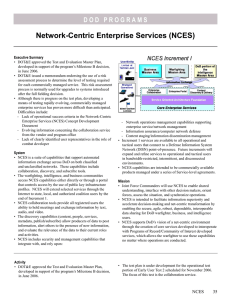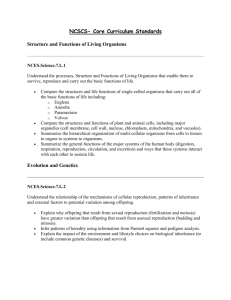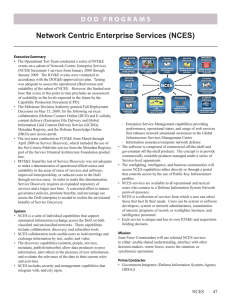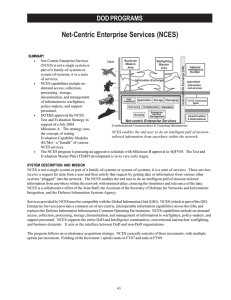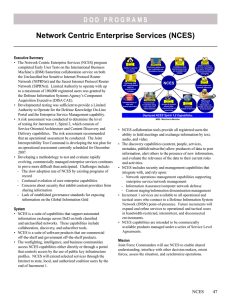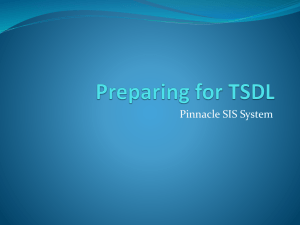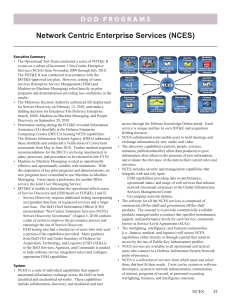Network Centric Enterprise Services (NCES)
advertisement
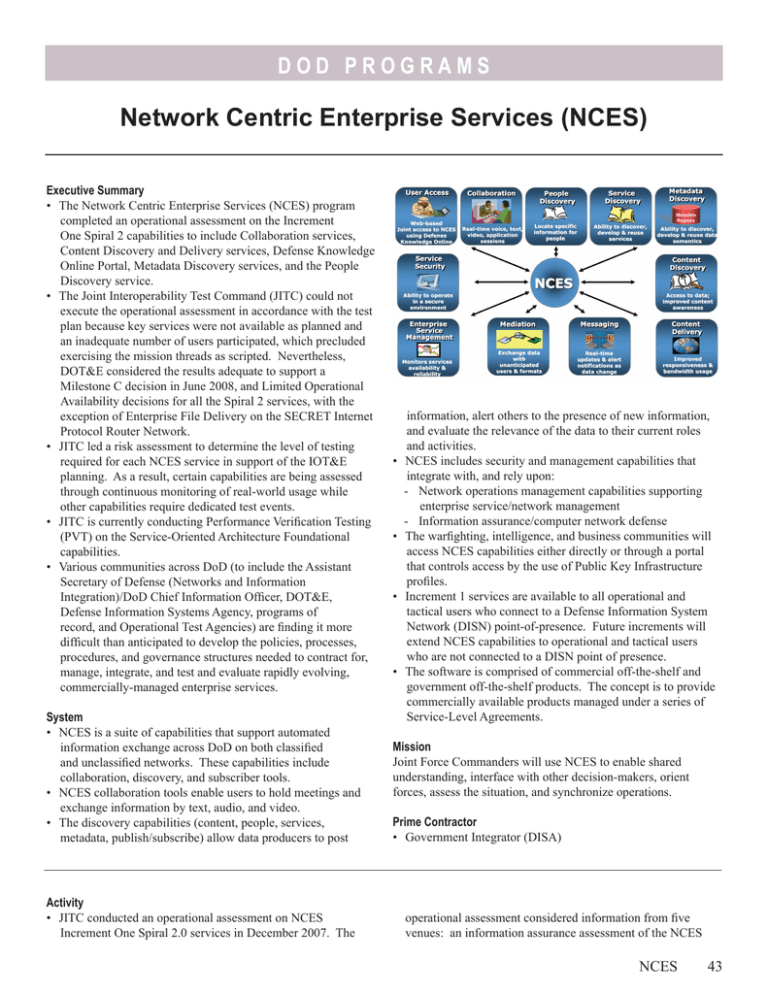
DOD P RO G R A M S Network Centric Enterprise Services (NCES) Executive Summary • The Network Centric Enterprise Services (NCES) program completed an operational assessment on the Increment One Spiral 2 capabilities to include Collaboration services, Content Discovery and Delivery services, Defense Knowledge Online Portal, Metadata Discovery services, and the People Discovery service. • The Joint Interoperability Test Command (JITC) could not execute the operational assessment in accordance with the test plan because key services were not available as planned and an inadequate number of users participated, which precluded exercising the mission threads as scripted. Nevertheless, DOT&E considered the results adequate to support a Milestone C decision in June 2008, and Limited Operational Availability decisions for all the Spiral 2 services, with the exception of Enterprise File Delivery on the SECRET Internet Protocol Router Network. • JITC led a risk assessment to determine the level of testing required for each NCES service in support of the IOT&E planning. As a result, certain capabilities are being assessed through continuous monitoring of real-world usage while other capabilities require dedicated test events. • JITC is currently conducting Performance Verification Testing (PVT) on the Service-Oriented Architecture Foundational capabilities. • Various communities across DoD (to include the Assistant Secretary of Defense (Networks and Information Integration)/DoD Chief Information Officer, DOT&E, Defense Information Systems Agency, programs of record, and Operational Test Agencies) are finding it more difficult than anticipated to develop the policies, processes, procedures, and governance structures needed to contract for, manage, integrate, and test and evaluate rapidly evolving, commercially-managed enterprise services. System • NCES is a suite of capabilities that support automated information exchange across DoD on both classified and unclassified networks. These capabilities include collaboration, discovery, and subscriber tools. • NCES collaboration tools enable users to hold meetings and exchange information by text, audio, and video. • The discovery capabilities (content, people, services, metadata, publish/subscribe) allow data producers to post Activity • JITC conducted an operational assessment on NCES Increment One Spiral 2.0 services in December 2007. The • • • • information, alert others to the presence of new information, and evaluate the relevance of the data to their current roles and activities. NCES includes security and management capabilities that integrate with, and rely upon: - Network operations management capabilities supporting enterprise service/network management - Information assurance/computer network defense The warfighting, intelligence, and business communities will access NCES capabilities either directly or through a portal that controls access by the use of Public Key Infrastructure profiles. Increment 1 services are available to all operational and tactical users who connect to a Defense Information System Network (DISN) point-of-presence. Future increments will extend NCES capabilities to operational and tactical users who are not connected to a DISN point of presence. The software is comprised of commercial off-the-shelf and government off-the-shelf products. The concept is to provide commercially available products managed under a series of Service-Level Agreements. Mission Joint Force Commanders will use NCES to enable shared understanding, interface with other decision-makers, orient forces, assess the situation, and synchronize operations. Prime Contractor • Government Integrator (DISA) operational assessment considered information from five venues: an information assurance assessment of the NCES NCES 43 DOD P RO G R A M S host sites, mission thread execution, a Command and Control Data Pilot led by U.S. Strategic Command, the Global Information Systems Management Center Help Desk support, and unstructured user participation. • JITC conducted an information assurance assessment in December 2007 that focused on a review of documentation, interviews with security and system administrator personnel, and observations of system operations to determine whether the established information assurance policies and procedures were adequate to protect the systems or services. • JITC began PVT in May 2008 on NCES services that did not have sufficient previous testing or had no testing. PVT focuses on assessing technical performance parameters outlined in the Capability Production Document (CPD). • The joint operational test community revised the critical operational issues in the updated NCES Test and Evaluation Master Plan to support the current acquisition strategy, which recommends unbundling the individual NCES capability sets into discrete deployment decisions. The NCES program formalized implementation plans in Memoranda of Agreement (MOA) with programs of record and communities of interest to assess the contribution of NCES towards their individual missions. Assessment • JITC could not conduct the operational assessment in accordance with the approved test plan as key services were not available and an insufficient number of users exercised the mission threads as scripted. However, the testing was adequate to support a recommendation to proceed to Milestone C. • The scope of testing during the operational assessment varied, as some services were tested in previous Early User Tests (for example, E-Collabcenter collaboration service), some were existing operational capabilities (Portal, Content Delivery, Metadata Registry), some were immature (Joint Enterprise Directory Service), and in some cases, appropriate users were not available to demonstrate the contribution to mission (Machine-to-Machine Messaging). • The operational assessment highlighted two aspects of the NCES development effort: - The NCES services are maturing at different rates, with some services approaching sufficient maturity for operational testing and others requiring further development. - The implementation and adoption of the services are also progressing at different rates. • NCES Increment One services are a collection of disparate services with distinct user groups. The IOT&E will be a series 44 NCES of separate events designed to exercise a single service or set of services that have been adopted by a defined set of users per the MOAs. • Both the E-Collabcenter and Defense Connect Online (DCO) collaboration capabilities are available to 100,000 registrants. Issues with latency and audio performance are still prevalent especially for large meetings. • The Defense Knowledge On-line (DKO) Portal underwent successful software upgrades in April 2008 on the classified environment and in June 2008 on the unclassified environment. Infrastructure upgrades to support 2.5 million accounts on the unclassified environment were completed in September 2008. - Scalability assessments were successful for the classified environment. Testing of the unclassified environment, which must be capable of supporting 750,000 active authorized users by the end of Increment One, is scheduled for November 2008. - While DKO provides access points to the other NCES services, available services have not established a single sign-on capability as required by the CPD. Only the Metadata Registry has successfully established a single sign-on interface with DKO. • Testing has been hampered by: - The slow adoption rate of NCES by existing programs of record - The continual evolution of core enterprise capabilities - The level of effort needed for programs to expose their capabilities using NCES - The lack of established governance standards for exposing information on the Global Information Grid Recommendations • Status of Previous Recommendations. Effective action has been taken on all previous recommendations. • FY08 Recommendations. 1. The Milestone Decision Authority should modify the decision supported by the IOT&E from “full-fielding” to continued expansion of “Limited Operational Availability” so that those products that are not yet fully mature and that are being gradually adopted are reassessed periodically. 2. The Operational Test Agencies should fully leverage actual service operating experience to assess trends over time, including adoption rates, sustainability, product improvements, and improvements in end-to-end information exchange. JITC should gather metrics to assess NCES’ contribution towards the reuse of registered services.
